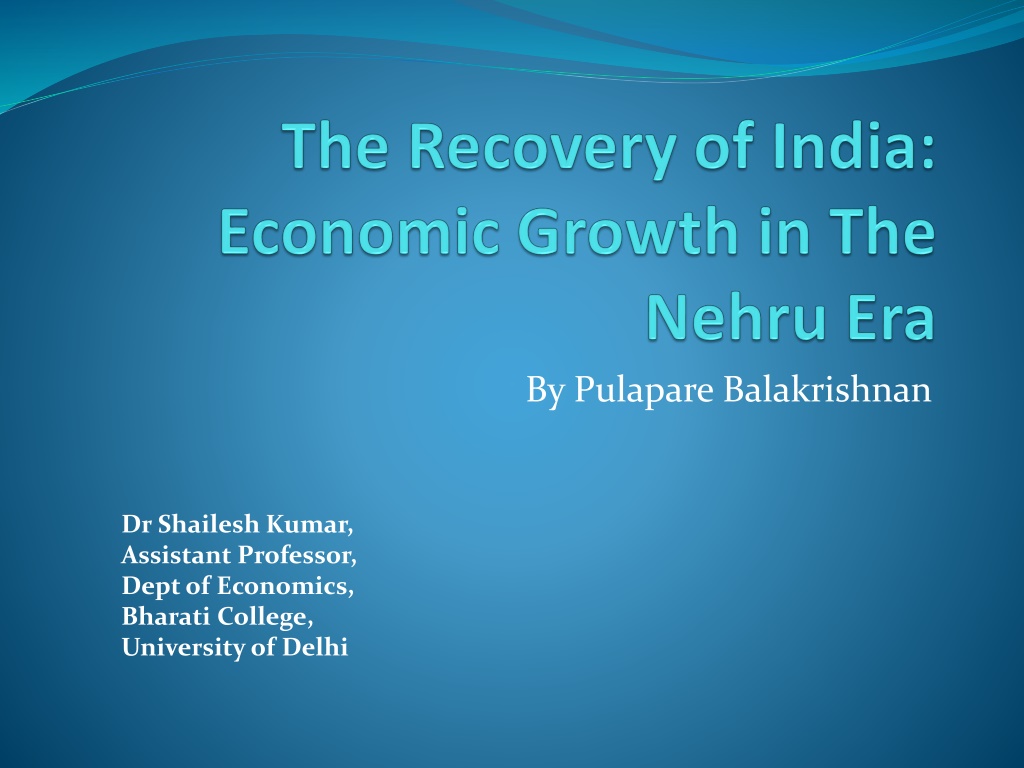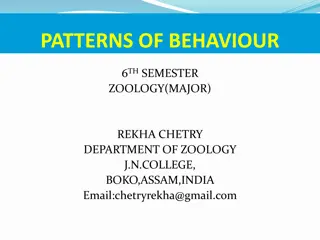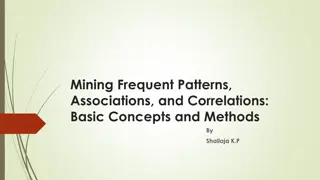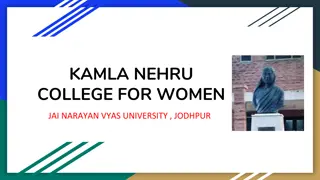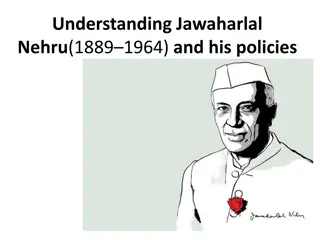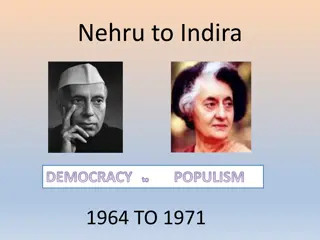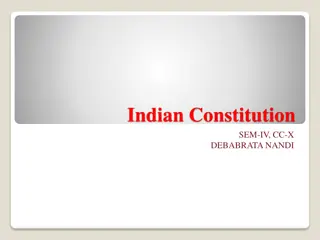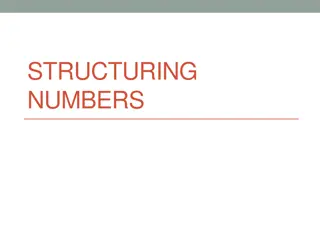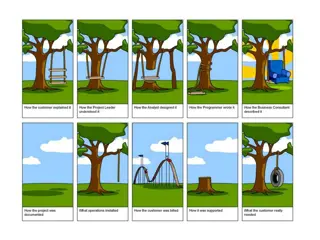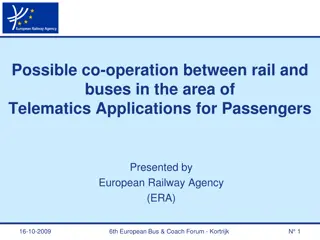Exploring the Nehru Era: Growth Patterns and Economic Strategies
Investigate the growth patterns during the Nehru Era (1950-1964), highlighting the different views on its impact, including the Nehru-Mahalanobis model and Vakil-Brahmananda plan. The era saw debates on whether it was a wasted period or a period of growth due to factors like growth transition and state-directed policies, leading to prosperous economic outcomes. The Nehru-Mahalanobis model focused on industrialization, income level increases, and poverty elimination, emphasizing on improving the industrial sector for economic development.
Uploaded on Oct 10, 2024 | 0 Views
Download Presentation

Please find below an Image/Link to download the presentation.
The content on the website is provided AS IS for your information and personal use only. It may not be sold, licensed, or shared on other websites without obtaining consent from the author. Download presentation by click this link. If you encounter any issues during the download, it is possible that the publisher has removed the file from their server.
E N D
Presentation Transcript
By Pulapare Balakrishnan Dr Shailesh Kumar, Assistant Professor, Dept of Economics, Bharati College, University of Delhi
Nehru Era: 1950-1964 Nehru Era: 1950-1964 The author is trying to investigate the growth pattern during this period. Now as a background we should know that this era was faced by lot of critics because of the model or the kind of approach and strategies for growth it had. Usually there were some specific types of growth model being followed: The idea of self reliance Import substitution strategies and two particular models which the author also discusses Nehru- Mahalanobis model and Vakil- Brahmananda plan
So, essentially author has been trying to suggest that there was a divided view in this particular Nehru Era. There was a divided view of : A wasted past this era was nothing much but it reunion India as such And the second view or debated view is watershed era of growth In the second view which Balakrishnana tries to contra argue that it was not true to that 1950 to 1964 was a wasted period or a lag period or India suffer during that time but due to specific reasons like growth transition happening, high state directedness etc. Indian economy to really prosperous in this Nehru Era period.
First core model is Nehru Mahalnobis Model: This model was given by Pt Jawaharlal Nehru and P C Mahalnobis. Salient features or assumptions: 2-Sector model: first sector being Consumer Goods(C) and Capital Goods (K) So, essentially total output or the economy as such was defined as the sum of capital and consumer goods: Y=K+C Capital was not subject to diminishing MR It essentially mean that if you have increase of capital but it does not diminish as such but it keeps on increasing your output, your productive base K g productive base It was assume to be endless which is quite to be a limited assumptions for a point Closed Economy: means there was no foreign aid, no assistance as such to be taken for India s growth
Objectives: Increase in the income levels of the people/economy High emphasis on Industrialisation Eliminate poverty High emphasis on industrialisation basically high focus on improving the industrial sectors growth it will lead to increase in the income levels of the people of the economy which will eventually lead to eliminating poverty. So moving from a macroeconomic perspective to your poverty or socio developmental perspective. This was the main idea of this model.
HEART of N-Mmodel: focus on Heavy Goods sector K only 1. Large gestation period 2. State only could afford Heavy goods: machine building complexes with a large capacity for machinery manufacture to produce steel, chemicals, electricity, transport, equipments, etc. or production of goods(such as coal or steel) that are used to make other goods. Thus we have to first invest in the capital goods sector according to Nehru so either we can export them but this lead to disequilibrium in the BOP or we can produce our own goods (self reliance). Thus all the steel plants was established during Nehru s time like Durgapur Steel Plant, Bhilai Steel Pant, etc. To establish a plant, a infrastructure (roads, water, brigdes, labor, hospital, clinic, market) was developed which led to the economic growth Investment in K => fuel both consumer goods and capital goods C C & K Allocation also as: K>>>C K => Productive base of economy Enhanced role of Public Sector
Enhanced role of Public sector: very important, it will be investment by the state, by the government. It will aid in industrial growth, income level and eliminating poverty Major criticisms of this model: A supply side model it ignores the demand side constraints. Supply side model means that this model only explains that how and by whom investment is to be done (which is government). Thus there is no private ownership. Thus Investment is done increase in employment increase in purchasing power This model gives money into hands (supply side) by reinvesting via industrialisation. But Balakrishnan counter argues this that it was not so true. It is mention in the paper also how he says that in the basic framing of this model demand side constraints we discussed but if we see the overall result n entire emphasis of this model it seen that it was essentially a supply side mode.
Demand side model:Which depends on consumers what is demand side model: for e.g. consumers already have shoes but there is a supply of shoes by production of it in the market so there will be a fake demand created by giving discounts. Thus by creating atmosphere, demand created. Thus both, supply side model and demand side model is targeting consumers, one by giving money into the hands and one by creating fake demand. Low discount rate: basically people prefer to have short run gains only and not seek for long term. People had less patience level. And this was like contradiction to the framing of this model which suggested that long run growth is at the cost of short run gain. No attention to saving constraints No mention of taxation Limit about foreign aid being zero or interaction being zero Model is also related to smaller country A Deshai : there was no mention of unemployment, inflation.
Vakil and Brahmananda Plan An alternate to N-M Model Focus: wage goods sector wage-good is a good that a wage earner might buy; it's a consumption good: Food-grains; Cereals, Pulses, Milk and Milk Products, Edible oils, Fish, Eggs and Meat, Sugar and Sugar Products, Fruits and Vegetables, Spices, Tea, Coffee, Cloth, Matches, Soap, Salt, and Kerosene. Non-wage-good is good that an interest-collector (or profit-maker) might buy; it's a capital good, or investment good. Reason of unemployment and poverty in India: lack of wage goods to remove this poverty it is essential to increase the aggregate supply of wage goods. Unless and until the wage-goods gap is bridged, poverty will not be eliminated. It believe in the process of multiplier process. Multiplier process suggest that we are focusing from the basics Agriculture Industry maximum growth It means highest priority to wage-goods industries, especially agriculture, in allocation of investment resources.
Vakil-Brahmananda Plan: Prominent Economist like, C N Vakil and P R Brahmananda advocated Wage Good model for the development of the Indian economy and Industrialisation. Vakil and Brahamanda differed from the Mahalanobis strategy as they believe At the low level of consumption (this was the situation in India) the productivity of the workers depends on how much they consumed. According to them, if people were undernourished, they will lose their productivity and become less efficient, at this juncture it is necessary to feed them to increase their productivity. But this is not true for all consumer good; so they differentiated between Wage Good (whose consumption increase worker productivity) and Non- Wage Good (whose consumption did not). To sum up, Wage Good model says; worker s productivity depends on not on whether they use machines to produce goods but also on the consumption of wage goods like, food, cloth and other basics. Therefore, the first step towards development is to mechanize agriculture and raise food production; once this objective is reached, one should go for Mahalanobis strategy of Heavy Industrialisation.
N-M versus V-B Models Nehru Mahalnobis Model Vakil Brahmananda Model Focus: Heavy goods sector Focus: Wage goods sector Supply-side Model Emphasis : Demand-side or primary necessities approach Stress on Industrial Development Stress on Agricultural Development N-M Model is also called the second five year plan model. N-M Model was claim to be inspired by Feldman s Model. Feldman s Model was for Soviet Union. But Mahalnobis said that well he was not aware, the usually claim so. But it was inspired. Qn. Explain the characteristics of the model inspired by Feldman or inspired by Soviet Union. Or Qn. Explain the characteristics of that model which was Second Five Year Plan Model. N-M model > V-B model External sector could not be utilized- a big limitations(in both model)
Lack of engine of growth is the real cause . How do we propel growth. Capacity building was the major issue whether we focus on agriculture first or industry first. But according to Balakrishnan basic issue was something else. It was the engine of growth. Agriculture and an industry-they are interdependent, they are essentials. Need agricultural growth for industrial prosperity and industrial growth for agricultural prosperity. Both are interdependent and essential for each other. Qn on Raj Krishna statement: 4% growth rate in agriculture industry=0 Or 7% growth rate in industry agriculture=0 (complete neglect of agriculture)
Misconceptions and Neglects : Nehru Era 1. Neglect of Agriculture: agriculture is important but not more stress on agricultural development At policy level-neglect At resource level: insufficient allocation P Balakrishnan: Agriculture was not neglected completely but its growth rate could be higher. Because there was 22.7% investment in agriculture in the three five year plans. There was guaranteed minimum support price, subsidies etc. 2. Role of public sector enterprises: heavy responsibility because of investments, promoting the growth no reliance on foreign aid IPR(1966)-Heavy responsibility on public sector(only) v/s private sector P Balakrishnan: public sector was not a black hole or wasted legacy in Nehru Era, as claimed due to factual evidences: its not true. But public sector had very big role. fund base could only increase because of public sector, mobilisation of resources this was also possible because of public sector So, public sector was not a black hole. 3. Neglect of Primary education Less funds Less importance assigned to education
CONCLUSIONS Nehru Era: a mix of positive and negatives Indian economy more competitive : 1. income level increase, 2. Industry relatively doing well 3. Interlinking b/w Agri. & Industry 4. expansion of economic infrastructure in the form of irrigation, energy, transport and communication 5. rise in savings and investment rate But Major role of state & government intervention What kind of role did state planning and government play in shaping the growth of country? (Good or bad in terms of growth in Nehru Era) Complete closeness to foreign capital Technological backwardness in production => productivity Lack of competition and hence poor quality of consumer goods Unaccountable public sector, corruption also present Neglect of Small Scale Industries(labour intensive) consumer goods
Nehruvian Socialism: increasing income Y, Industry > Agriculture leads to Poverty reduction, Education, License Raj & red-tapism, Planning Commission etc Education, esp. primary education ironically suffered much in Nehru Era
